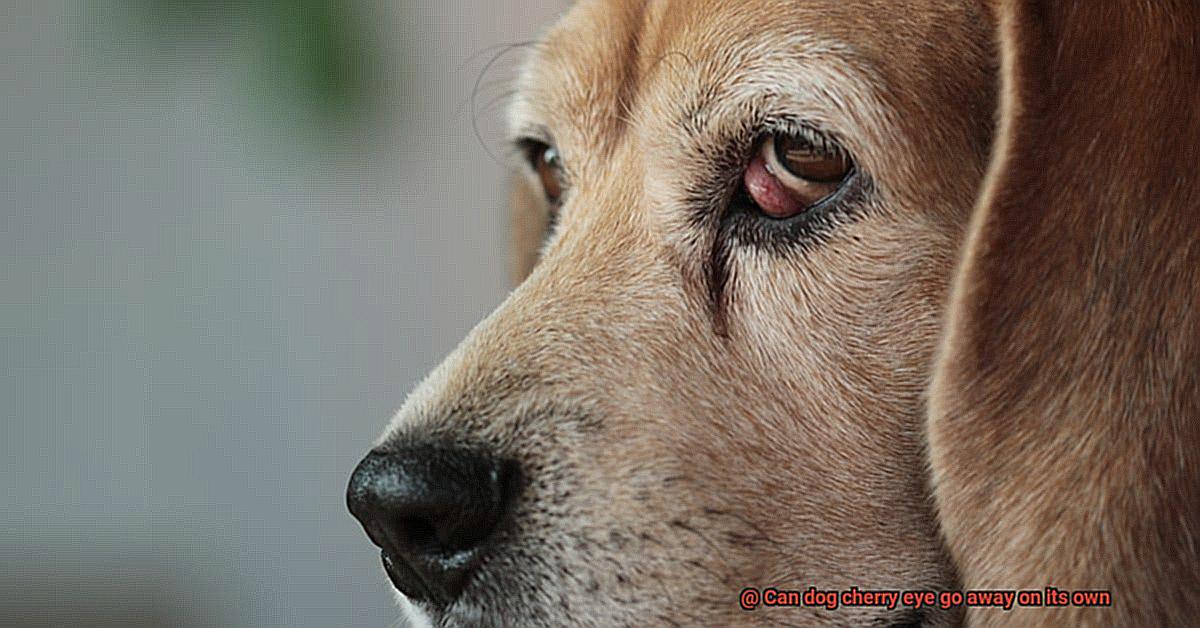Can dog cherry eye go away on its own?
If you’re a dog owner, chances are you’ve heard of “cherry eye” before. Despite its fruity name, cherry eye is actually a common eye issue that can affect dogs of all shapes and sizes. But can dog cherry eye go away on its own? Let’s dive into the world of this peculiar ocular anomaly and explore the potential treatment options available.
Cherry eye, scientifically referred to as prolapse of the nictitating membrane, presents itself as a red, swollen mass that protrudes from the inner corner of your furry friend’s eye. This swelling occurs when the gland responsible for producing tears and aiding in lubrication becomes displaced or prolapsed. While any breed can experience cherry eye, certain breeds like Beagles, Bulldogs, and Cocker Spaniels are more genetically prone to this condition.
While it may be tempting to hope that cherry eye will magically disappear without intervention, it’s important to understand that this isn’t always the case. In fact, leaving cherry eye untreated can lead to discomfort, vision problems, and even secondary eye infections. Fortunately, there are several treatment options available that effectively address cherry eye and provide relief for your beloved pup.
Surgical repair is one of the most commonly recommended treatments for cherry eye. During this procedure, the prolapsed gland is surgically repositioned back into its normal position. However, some veterinarians may suggest non-surgical approaches such as manually massaging the gland back in place or using medication to reduce swelling. To determine the best course of action for your dog’s specific situation, consulting with a veterinarian is crucial.
In this blog post, we’ll delve deeper into canine cherry eye by exploring its causes, symptoms, potential long-term implications, and available treatment options. By gaining a better understanding of this condition, you’ll be able to take proactive steps towards ensuring your furry friend’s visual health and overall well-being. Stay tuned for our forthcoming informative sections that will provide clarity on this eye condition and guide you in making informed decisions for your dog’s health and happiness.
Can dog cherry eye go away on its own
Contents
- 1 Can dog cherry eye go away on its own
- 2 Can Dog Cherry Eye Go Away on Its Own?
- 2.1 What Exactly is Cherry Eye and What Causes It?
- 2.2 Signs and Symptoms: What to Look Out For
- 2.3 Why Veterinary Intervention is Often Essential
- 2.4 Treatment Options: What’s in the Toolbox?
- 2.5 Potential Complications: The Dangers of Ignoring Cherry Eye
- 2.6 Prevention is Key: Tips to Keep Cherry Eye at Bay
- 3 What Causes Dog Cherry Eye?
- 4 Potential Complications of Leaving Dog Cherry Eye Untreated
- 5 The Most Common Treatment for Dog Cherry Eye
- 6 Rare Instances Where Dog Cherry Eye Resolves on Its Own
- 7 Conservative Management Techniques for Treating Dog Cherry Eye Symptoms
- 8 Why It’s Important to Seek Veterinary Treatment for Dog Cherry Eye
- 9 Conclusion
If you’re a dog owner, you may have heard of cherry eye, a condition that commonly affects certain breeds like French Bulldogs. It’s natural to wonder if this condition can resolve on its own without any intervention.
While there are rare cases where cherry eye may go away temporarily, it is unlikely in most situations. In this blog post, we will explore the potential for dog cherry eye to go away on its own and why surgical intervention is often needed for effective treatment.
Understanding Cherry Eye:
Cherry eye occurs when the tear gland in the dog’s third eyelid becomes swollen and protrudes, resembling a cherry. This condition can be uncomfortable for dogs and may lead to complications such as dryness, irritation, and an increased risk of infections. Once the gland prolapses, it loses its attachment to the surrounding tissue, making it difficult to retract back into its normal position without assistance.
The Importance of Veterinary Intervention:
While spontaneous resolution of cherry eye is possible, it is not very common. Without treatment, the condition can cause discomfort and potentially lead to more severe complications. Surgical correction is often recommended by veterinarians to reposition the gland back into place and secure it to prevent further prolapse. This procedure, known as “tacking” or “pocketing,” provides a more permanent solution and reduces the likelihood of recurrence.
Monitoring vs. Surgery:
In some cases, if the cherry eye is mild or not causing any complications, veterinarians may choose to monitor the condition closely before recommending surgery. However, this approach is only considered if there are no signs of discomfort or complications. It’s important to note that even if cherry eye goes away on its own temporarily, there is a high chance of recurrence due to the weakened attachment of the gland.
Can Dog Cherry Eye Go Away on Its Own?
We’re here to shed some light on whether this condition can magically vanish or if intervention is necessary. So sit back, relax, and let’s dive into the world of dog cherry eye.
What Exactly is Cherry Eye and What Causes It?
First things first, let’s understand the nitty-gritty of cherry eye. This condition occurs when the tear gland in your furry friend’s eye becomes inflamed and pops out of its usual spot. The exact cause is still somewhat of a mystery in the canine world, but it’s thought to involve weakened connective tissues or genetic predisposition.
Signs and Symptoms: What to Look Out For
To play detective, you need to know the clues. Keep an eye out for redness, swelling, and a noticeable pinkish mass in the corner of your pup’s eye. Excessive blinking or rubbing and watery discharge are also common signs.
Factors Influencing Spontaneous Resolution
Now, here comes the million-dollar question: Can cherry eye disappear on its own? Well, it’s like catching a shooting star – possible but not very likely. Several factors come into play here, such as the severity of the condition, your dog’s age, and overall health.
In mild cases with minimal gland protrusion, there might be a higher chance of spontaneous resolution.
Why Veterinary Intervention is Often Essential
Despite the faint glimmer of hope for spontaneous resolution, it’s crucial to seek veterinary assistance for your French bulldog’s cherry eye. Why? Well, leaving it untreated can lead to discomfort, potential complications like dry eye syndrome, and an increased risk of recurrence.
Treatment Options: What’s in the Toolbox?
Your trusty vet will assess the severity of the condition and propose appropriate treatment options. These may include topical medications, manual gland repositioning, or in most cases, surgical intervention to restore the gland’s proper position and function.
Potential Complications: The Dangers of Ignoring Cherry Eye
Imagine leaving a wrench in a well-oiled machine – things start to go awry. The same applies to ignoring cherry eye. Leaving it untreated can lead to chronic inflammation, dry eye syndrome, corneal ulcers, and decreased tear production. Yikes.
Prevention is Key: Tips to Keep Cherry Eye at Bay
An ounce of prevention is worth a pound of cure. While cherry eye may strike unexpectedly, there are a few measures you can take to minimize the risk. Avoid excessive rubbing or trauma to your dog’s eyes, maintain good overall eye health with regular check-ups, and consider genetic screening if you’re planning on bringing home a French bulldog pup.
What Causes Dog Cherry Eye?
Let’s talk about cherry eye in our furry friends. You know, that adorable, but sometimes concerning, little red bump that pops out from the corner of their eye? Yep, that’s what we’re diving into today. So, what exactly causes this cherry eye situation? Let’s get to the bottom of it.
Weak Connective Tissues – The Culprit Behind Cherry Eye
One of the main causes of cherry eye in dogs is weak connective tissues. You see, our doggos have this fancy gland called the nictitating membrane or third eyelid gland. It’s responsible for keeping their eyes moist and happy. But when the connective tissues supporting this gland become weak, it can lead to the gland prolapsing or protruding, resulting in that cherry-like appearance.
Genetics – Blame It on the Anatomical Predisposition
Now, here’s something interesting. Some breeds, like us French Bulldogs, Bulldogs, Beagles, Cocker Spaniels, and Shih Tzus, are more prone to cherry eye. Why? It all comes down to genetics and our unique anatomical predispositions. Breeds with shallow eye sockets or loose facial skin are particularly at risk of developing cherry eye. Blame it on our adorable faces.
Environmental Factors – Dust and Pollen Can Be Trouble
You know those pesky irritants like dust and pollen? Well, they can play a role in causing cherry eye too. When these irritants get into our eyes, they can cause inflammation and irritation, leading to the prolapse of the third eyelid gland. And let me tell you, excessive rubbing or scratching at our eyes due to allergies or foreign objects can also trigger this cherry eye situation.
Infections and Inflammation – The Sneaky Culprits
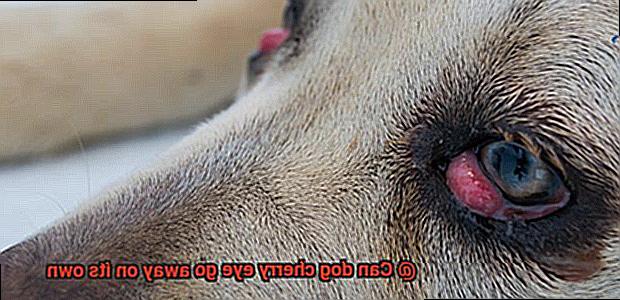
Sometimes, underlying eye infections or inflammation can be the sneaky culprits behind cherry eye. Conditions like conjunctivitis or keratitis can cause swelling and irritation in our eyes, which may result in the prolapse of that third eyelid gland. It’s important to treat these infections or inflammations promptly to resolve cherry eye.
Young Pups – More Prone to Cherry Eye
Now, here’s an interesting tidbit. Cherry eye is more commonly seen in young pups under two years old. Why? Well, it could be because their connective tissues are still developing and may be more prone to weakness or damage. So, keep an eye out for any bulging redness in those puppy eyes.
Potential Complications of Leaving Dog Cherry Eye Untreated
French Bulldogs are beloved pets known for their distinctive appearance and playful nature. However, like any other breed, they can be prone to certain health issues, including cherry eye.
Cherry eye is a condition where the gland in the corner of the dog’s eye becomes prolapsed and visible, resembling a cherry. While it may seem harmless, leaving cherry eye untreated can lead to potential complications that can impact your furry friend’s well-being.
In this article, we will explore the potential risks and issues associated with ignoring cherry eye in French Bulldogs.
Increased Risk of Irritation and Infection:
Leaving cherry eye untreated exposes the delicate gland to external irritants such as debris, dirt, and bacteria. This can cause inflammation and make the gland vulnerable to infection. Without prompt treatment, the risk of infection dramatically increases, leading to discomfort and potential complications.
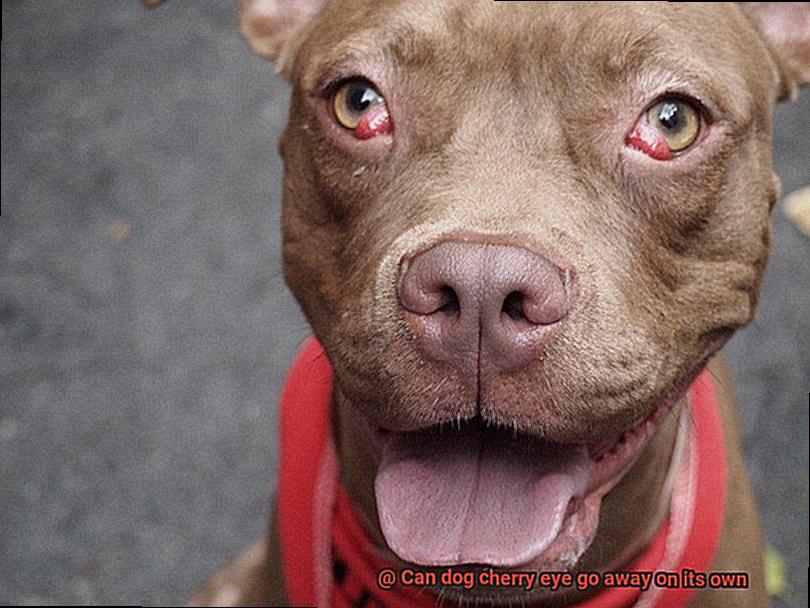
Progression to Serious Eye Conditions:
Ignoring cherry eye can result in more severe eye conditions, such as conjunctivitis or corneal ulcers. These conditions can cause pain, redness, discharge, and even vision loss if left untreated. Corneal ulcers, in particular, can be concerning as they can permanently damage the cornea and affect your Frenchie’s vision.
Potential Damage to the Gland:
Without proper intervention, the exposed gland may suffer further damage or degeneration over time. This can lead to shrinkage or scarring of the gland, resulting in reduced tear production and a condition called dry eye syndrome. Dry eye syndrome is uncomfortable for dogs and may lead to chronic eye problems if not managed effectively.
Cosmetic Issues:
The bulging red mass on the corner of your French Bulldog’s eye can be unsightly and may cause concern or discomfort for both you and your pet. Ignoring cherry eye may result in a long-term cosmetic issue that affects your Frenchie’s appearance.
Potential Irreducibility:
In some cases, if left untreated for an extended period, the prolapsed gland may become irreducible. This means it cannot be manually repositioned back into its normal position. Irreducible cherry eye often requires surgical intervention, which can be more complicated and costly than addressing the condition earlier on.
The Most Common Treatment for Dog Cherry Eye
French Bulldogs are beloved pets known for their adorable squished faces and playful personalities. However, they are also prone to certain health issues, including cherry eye. Cherry eye in French Bulldogs can be a cause for concern, but with the right knowledge and treatment, it can be effectively managed.
The Most Common Treatment: Surgical Correction
When it comes to treating cherry eye in French Bulldogs, surgical correction is the most common and effective approach. This procedure involves repositioning the prolapsed gland back into its normal position and securing it with sutures or adhesive. The surgery is typically performed under general anesthesia by a skilled veterinarian.
Post-Surgery Care:
After the surgery, it is crucial to provide proper care to ensure a smooth recovery for your French Bulldog. Here are some essential post-surgery care tips:
- Use an Elizabethan collar or cone to prevent your furry friend from scratching or rubbing their eyes.
- Administer prescribed medication, including antibiotics and anti-inflammatory drugs, to manage pain and prevent infection.
- Follow the veterinarian’s instructions on applying eye drops or ointments to aid in healing.
- Limit your dog’s physical activity during the recovery period to prevent strain on the eyes.
- Schedule follow-up appointments with your veterinarian for suture removal and progress checks.
Potential Recurrence:
While surgical correction offers a high success rate, there is still a small risk of cherry eye recurrence in French Bulldogs. Regular monitoring by a veterinarian is essential to catch any potential issues early on and take appropriate action.
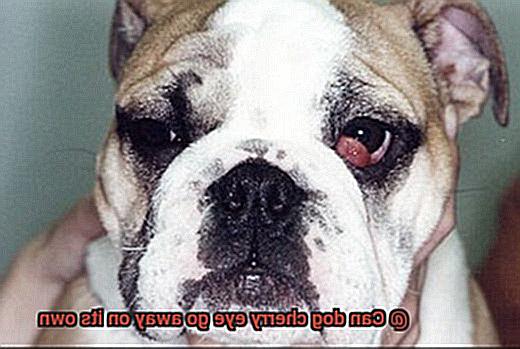
Rare Instances Where Dog Cherry Eye Resolves on Its Own
If you’re a French Bulldog owner, you may have heard of cherry eye – a condition where the gland in your dog’s eye becomes swollen and protrudes from the corner of their eye.
While surgical intervention is usually required to treat cherry eye, there have been rare instances where the condition resolves on its own without any medical intervention.
In this article, we’ll explore these rare instances and discuss why it’s still important to consult with a veterinarian.
Why Does Cherry Eye Resolve on Its Own?
The likelihood of spontaneous resolution of cherry eye varies depending on factors such as the severity of the condition, the age of the dog, and the breed. Puppies are more likely to experience natural healing compared to adult dogs.
This is because their immune systems are still developing, and their tissues are more prone to healing naturally. In fact, some French Bulldog owners have reported cases where cherry eye resolved without any treatment.
The Importance of Close Monitoring
While it’s exciting to hear that cherry eye can resolve on its own, it’s crucial to remember that even in these rare instances, close monitoring and regular vet check-ups are necessary.
Although the cherry eye may resolve initially, there is still a risk of recurrence or other complications if left untreated. Regular check-ups with a veterinarian can help ensure your dog’s eyes remain healthy and catch any potential issues before they worsen.
Continued Eye Care
If your dog’s cherry eye does resolve on its own, congratulations. However, it’s important to continue providing proper eye care to prevent future occurrences. Keep their eyes clean by gently wiping them with a clean cloth or using veterinarian-approved wipes.
Avoid irritants such as smoke or chemicals that could irritate their eyes. Additionally, ensure your dog has a healthy diet rich in essential nutrients to support overall eye health.
Consulting with a Veterinarian
Even if you believe your dog’s cherry eye may resolve on its own, it’s important to consult with a veterinarian. A professional evaluation can help determine the best course of action and ensure that any necessary treatment is provided promptly.
Your veterinarian will be able to assess the severity of the condition, provide guidance on management and preventative measures, and address any concerns you may have.
Conservative Management Techniques for Treating Dog Cherry Eye Symptoms
Cherry eye, also known as prolapse of the third eyelid gland, is a common condition that can affect dogs, including our beloved French Bulldogs. While surgery is often recommended for severe cases, conservative management techniques can be effective in managing mild to moderate cherry eye symptoms.

In this article, we will explore some practical and non-surgical approaches to help alleviate cherry eye symptoms in French Bulldogs.
Topical Medications:
Topical medications, such as ointments or eye drops prescribed by your veterinarian, can help reduce inflammation and promote healing of the affected gland. They should be applied directly to the eye as instructed.
Warm Compresses:
Applying warm compresses to the affected eye can provide soothing relief and reduce swelling. Gently place a clean cloth soaked in warm water on the eye for a few minutes, several times a day.
Gentle Massage:
Massaging the area around the affected gland can stimulate blood flow and promote proper gland function. Use gentle circular motions with your fingertips to massage the area, but be cautious not to apply too much pressure.
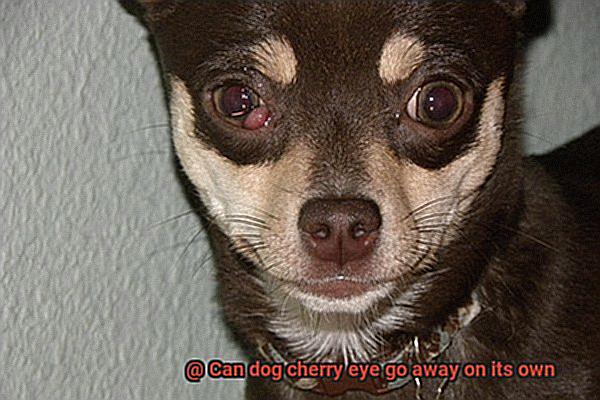
Consider Using a Harness:
Using a harness instead of a collar can help minimize pressure on the neck and reduce the risk of inflammation or irritation around the eye area.
Proper Eye Hygiene:
Maintaining good eye hygiene is essential. Regularly wipe the affected eye with a clean cloth or cotton ball soaked in saline solution to remove any debris or discharge.
Nutritious Diet:
Providing a healthy diet rich in antioxidants, omega-3 fatty acids, and vitamins A, C, and E can support proper tear production and maintain good eye health in French Bulldogs.
Remember, while these conservative management techniques can provide symptomatic relief, they may not fully resolve cherry eye. It’s crucial to consult with your veterinarian for a proper diagnosis and to discuss the best course of action for your French Bulldog.
Conservative management techniques can be effective in managing mild to moderate cherry eye symptoms in French Bulldogs.
By combining topical medications, warm compresses, gentle massage, proper eye hygiene, and a nutritious diet, you can provide relief and support your furry friend’s eye health.
However, it’s important to work closely with your veterinarian to monitor the condition and consider surgical intervention if necessary.
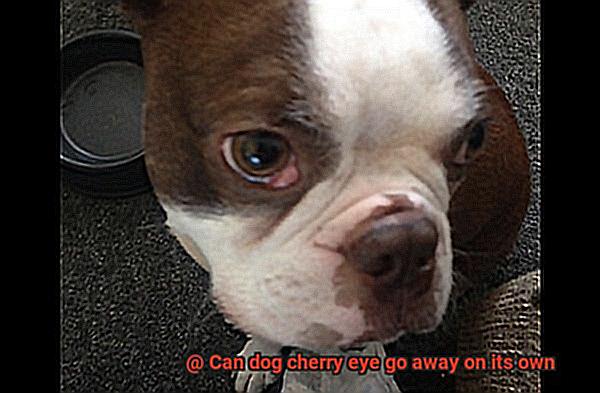
Why It’s Important to Seek Veterinary Treatment for Dog Cherry Eye
If you have a French Bulldog, you may be familiar with the condition called cherry eye. It’s when the gland of the third eyelid prolapses, causing a red, swollen mass to protrude from the corner of your dog’s eye.
While you might wonder if cherry eye can go away on its own, it is generally recommended to seek veterinary treatment for this condition. In this article, we will explore why it’s important to seek professional help and the potential complications that can arise if left untreated.
Complications of Untreated Cherry Eye:
- Irritation, Inflammation, and Infection: The exposed gland in cherry eye becomes vulnerable to irritation, inflammation, and infection, leading to discomfort and pain for your furry friend. Seeking veterinary treatment can help alleviate these symptoms and prevent further complications.
- Dry Eye Syndrome (KCS): If left untreated, cherry eye can result in dry eye syndrome or keratoconjunctivitis sicca (KCS). KCS occurs when tear production in the affected eye decreases, leading to dryness and potential damage to the cornea. Early veterinary intervention can help prevent or manage KCS effectively.
- Chronic Eye Problems and Potential Vision Impairment: Delaying or avoiding veterinary treatment may result in chronic eye problems for your French Bulldog. Without proper care, cherry eye can lead to long-term complications that could potentially impair your dog’s vision.
The Importance of Veterinary Treatment:
- Surgical Intervention: While self-resolution of cherry eye is extremely uncommon, especially in adult dogs, veterinary professionals have the expertise to perform surgical repositioning or removal of the prolapsed gland. Attempting to manipulate the gland without proper training can cause further damage or injury to the eye.
- Preventing Long-Term Consequences: Seeking veterinary treatment early on can help prevent complications associated with cherry eye from occurring or worsening. With professional care, your French Bulldog has a higher chance of recovering fully and maintaining good eye health in the long run.
- Professional Expertise: Veterinary professionals have the knowledge, skills, and resources to properly diagnose and treat cherry eye in dogs. They can determine the most appropriate course of action based on the severity and individual circumstances of each case.
Conclusion
Dog cherry eye, also known as prolapse of the third eyelid gland, is a common condition in dogs where the gland in the corner of their eye becomes swollen and protrudes. Many pet owners wonder if this condition will go away on its own without any intervention. Unfortunately, the answer is not straightforward.
In some cases, dog cherry eye may resolve on its own without any treatment. However, this is relatively rare and usually happens in mild cases or in very young puppies. The gland may spontaneously return to its normal position within a few weeks or months.
However, for most dogs with cherry eye, medical intervention is necessary. Leaving it untreated can lead to complications such as chronic inflammation, dryness, and irritation of the exposed gland. It can also increase the risk of secondary infections and potential vision problems.
The most common treatment for dog cherry eye is surgical correction. This involves repositioning the gland back into its normal position and securing it to prevent future prolapse. While surgery may sound daunting, it is generally considered safe and effective in resolving cherry eye.
If you notice your dog’s third eyelid gland protruding, it’s best to consult with a veterinarian promptly. They will be able to assess the severity of the condition and recommend appropriate treatment options.
In conclusion, while there are rare cases where dog cherry eye may resolve on its own, it is generally recommended to seek veterinary care for proper diagnosis and treatment. Early intervention can help prevent complications and ensure your furry friend’s eyes stay healthy and comfortable.
